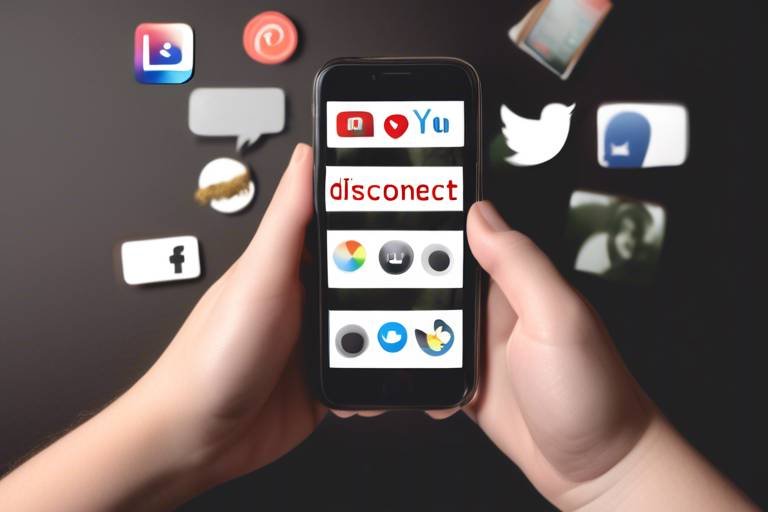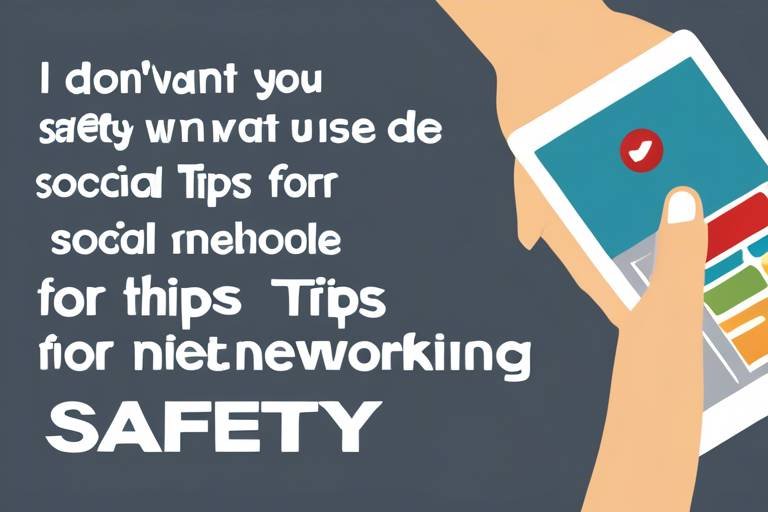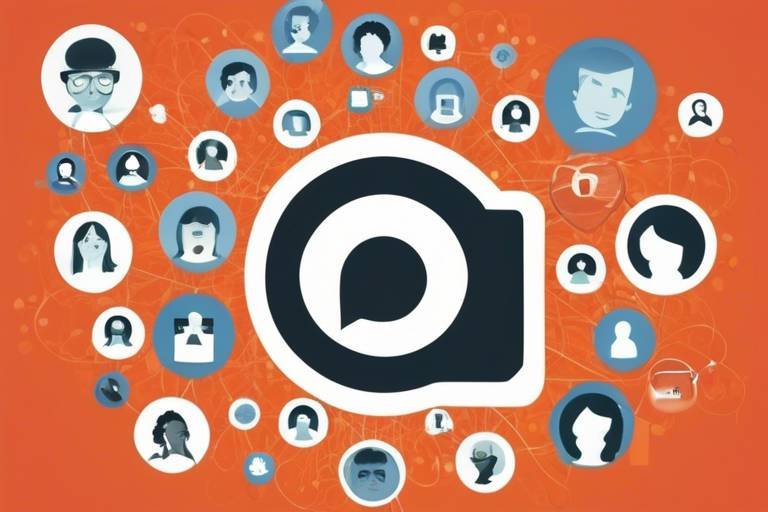Staying Safe in the Social Media World
In this digital age, social media platforms have become a vital part of our daily lives. They allow us to connect, share, and express ourselves like never before. However, with great connectivity comes great responsibility. Have you ever thought about how much personal information you share online? It's crucial to navigate these platforms with caution to protect your privacy and security. In this article, we'll explore essential strategies and tips to help you stay safe while enjoying the benefits of social media. So, let's dive into the world of social media safety and arm ourselves with knowledge!
Knowing how to adjust your privacy settings on social media is not just a good idea; it's a necessity. Think of your privacy settings as a protective shield around your personal information. Without it, you might as well be leaving your front door wide open for anyone to walk in. Most platforms offer various options to control who can see your content, send you messages, or even find your profile. Here’s a quick rundown on how to enhance your account's security:
- Review Your Privacy Settings: Regularly check your privacy settings to ensure they align with your comfort level. Adjust who can see your posts, friend requests, and personal information.
- Limit Profile Visibility: Consider making your profile private. This way, only approved friends can see your posts and information.
- Be Cautious with Friend Requests: Only accept requests from people you know. If someone reaches out and you don’t recognize them, it’s okay to ignore or block them.
Scams and phishing attempts are rampant on social media. Just like a wolf in sheep's clothing, these threats often disguise themselves as friendly messages or enticing offers. Being aware of how to identify these scams is your first line of defense. Look out for suspicious links, unsolicited messages, or accounts asking for personal information. Remember, if something seems too good to be true, it probably is!
As you navigate social media, it's essential to be aware of the most common scams that can catch you off guard:
- Fake Giveaways: Scammers often create fake contests or giveaways to lure users into providing personal information.
- Impersonation: Fraudsters may create fake profiles pretending to be someone you know, often to solicit money or information.
- Investment Fraud: Be wary of messages promising high returns on investments. These are often traps designed to steal your money.
Fake accounts can mislead users and spread misinformation, much like a mirage in the desert. To protect yourself, look for signs that an account may not be legitimate. Check for:
- A lack of profile picture or generic images.
- A limited number of friends or followers.
- Posts that seem overly promotional or spammy.
If you suspect an account is fake, report it to the platform to help maintain a safer online environment.
Knowing how to report scams is essential for keeping social media a safe space. If you encounter suspicious activities, take action! Most platforms have straightforward reporting mechanisms. Simply click on the options provided on the post or profile and follow the prompts. Your vigilance can help protect others from falling victim to these malicious schemes.
In the digital age, safeguarding your personal information is paramount. Think of your personal data as a treasure chest; you wouldn’t leave it unguarded, would you? Here are some best practices for sharing information responsibly:
- Think Before You Share: Always consider whether the information you’re about to share is something you’d want the entire world to see.
- Use Privacy Features: Utilize the privacy features offered by social media platforms to control who sees your posts and information.
Your password is your first line of defense against unauthorized access. Think of it as the lock on your treasure chest. A weak password is like using a flimsy lock that can be easily picked. To create a strong password, consider the following tips:
- Use a mix of letters, numbers, and special characters.
- Avoid common words or easily guessable information, like your birthday.
- Consider using a password manager to keep track of your passwords securely.
Two-factor authentication (2FA) adds an extra layer of security to your accounts. It’s like having a second lock on your treasure chest. Even if someone manages to get your password, they won’t be able to access your account without the second factor. Enabling this feature is simple and highly recommended for protecting your social media profiles.
Just like you wouldn’t ignore a rusty lock on your door, you should regularly update your security settings. Stay informed about new security features and adjust your settings accordingly. Many platforms frequently roll out updates to enhance user security, so make it a habit to check for these updates regularly.
Q: How can I tell if my account has been hacked?
A: Look for unusual activity, such as messages you didn’t send or changes to your profile information. If you notice anything suspicious, change your password immediately.
Q: What should I do if I encounter a scam?
A: Report the scam to the social media platform and consider alerting your friends to prevent them from falling victim.
Q: Is it safe to use public Wi-Fi for social media?
A: Be cautious when using public Wi-Fi. Avoid logging into sensitive accounts or sharing personal information unless you’re using a VPN for added security.
Q: How often should I change my passwords?
A: It’s a good practice to change your passwords every three to six months and immediately after any security breach.

Understanding Privacy Settings
This article explores essential strategies and tips to protect your privacy and security while navigating the ever-evolving landscape of social media platforms.
In the vast ocean of social media, your privacy settings act as your life raft. Knowing how to adjust these settings is not just a good idea; it’s crucial for maintaining your safety online. Every platform offers a variety of options to control who sees your content, who can contact you, and how your information is shared. But let’s be honest—navigating these settings can sometimes feel like trying to read a foreign language. So, let’s break it down into bite-sized pieces.
First things first, take a moment to dive into the settings menu of your preferred social media platform. Here, you will typically find a section labeled Privacy or Account Settings. This is your command center. Depending on the platform, you might encounter options like:
- Profile Visibility: Control who can see your posts and profile information.
- Friend Requests: Decide who can send you friend requests or follow your profile.
- Location Sharing: Manage whether to share your location with posts or check-ins.
Once you familiarize yourself with these options, take the time to adjust them according to your comfort level. For instance, if you’re not keen on strangers peeking into your life, consider making your profile private. This way, only people you accept can view your content. It's like having a digital doorman who only lets in guests you trust.
Moreover, be cautious of default settings. Many social media platforms have privacy settings that are set to public by default. This means that anyone, even people who aren't your friends, can see your posts. It’s like leaving your front door wide open while you’re not home—definitely not a smart move! Make it a habit to revisit your privacy settings regularly, especially after updates, as platforms often change their policies and features.
Another aspect to consider is the data sharing options. Many platforms allow you to control whether your data is shared with third-party apps or advertisers. It’s worth taking the time to review these settings because, let’s face it, no one wants their information sold to the highest bidder. By limiting data sharing, you not only protect your privacy but also reduce the amount of targeted advertising you receive, which can sometimes feel intrusive.
In summary, understanding and adjusting your privacy settings is essential for creating a safer social media experience. It empowers you to control your digital footprint and manage who has access to your personal information. Think of it as building a virtual fortress around your life—one that’s strong enough to keep unwanted intruders at bay.
Q: How often should I check my privacy settings?
A: It's a good practice to review your privacy settings every few months or whenever there's a major update to the platform.
Q: What should I do if I find a suspicious account?
A: Report the account to the platform immediately. Most social media sites have a straightforward reporting process.
Q: Can I change my privacy settings on mobile apps?
A: Yes, privacy settings can usually be adjusted through the app, just like on the desktop version.
Q: Are there any privacy settings I should prioritize?
A: Focus on profile visibility, friend request settings, and data sharing options as they are the most impactful on your privacy.

Recognizing Scams and Phishing
In today's digital landscape, scams and phishing attempts have become alarmingly common, especially on social media platforms. These malicious activities can range from simple attempts to steal your personal information to more sophisticated schemes designed to defraud you of your hard-earned money. So, how can you protect yourself? First, it’s essential to understand what these scams look like and how they operate. By being aware of the tactics used by scammers, you can better safeguard your information and navigate the social media world with confidence.
One of the most effective ways to recognize scams is to be vigilant about the messages and posts you encounter online. Often, scammers will employ social engineering tactics, manipulating emotions to elicit a response. For instance, you might receive a message claiming you've won a prize, but to claim it, you need to click a link and provide personal details. Always ask yourself: does this seem too good to be true? If it does, it probably is.
Moreover, be on the lookout for unsolicited messages from unknown users. These can often be phishing attempts where the scammer pretends to be someone you know or trust. They may send you links that lead to fake websites designed to harvest your personal information. Here are some red flags to watch for:
- Urgent language that creates a sense of panic.
- Requests for personal or financial information.
- Links that do not match the official website's URL.
Understanding the common types of scams can also empower you to spot them quickly. For example, fake giveaways are rampant on platforms like Instagram and Facebook, where scammers promise enticing prizes in exchange for likes, shares, or personal information. Similarly, impersonation scams involve fake accounts that mimic real users to gain your trust and extract sensitive data. Investment fraud is another prevalent issue, often masquerading as legitimate opportunities that promise high returns with little risk. Always conduct thorough research before engaging with any offers that seem suspicious.
To help you stay vigilant, here’s a brief overview of the most common scams you might encounter:
| Type of Scam | Description |
|---|---|
| Fake Giveaways | Scammers promise prizes in exchange for personal information or social media engagement. |
| Impersonation | Fake accounts mimic real users to gain trust and extract information. |
| Investment Fraud | Offers that promise high returns with little risk, often leading to financial loss. |
Lastly, recognizing and reporting scams is crucial for maintaining a safer online environment. If you encounter suspicious activity, don't hesitate to report it to the platform. This helps protect not just yourself, but also others who might fall victim to the same schemes. Always remember, staying informed is your best defense against the evolving tactics of cybercriminals.
Q: What should I do if I think I've been scammed?
A: If you suspect you've been scammed, immediately change your passwords and enable two-factor authentication on your accounts. Report the scam to the relevant social media platform and monitor your financial statements for any unauthorized transactions.
Q: How can I tell if a link is safe to click?
A: Hover over the link to see the URL it directs to. If it looks suspicious or doesn't match the official website, do not click it. You can also use link-checking tools to verify the safety of a URL.
Q: Are there any tools to help me recognize scams?
A: Yes, there are browser extensions and security software that can help identify phishing attempts and scams. Always keep your software updated to ensure maximum protection.

Common Types of Scams
In the bustling world of social media, scams are unfortunately all too common. As you scroll through your feed, it's essential to be aware of the various tactics scammers use to deceive unsuspecting users. Understanding these scams not only helps you protect yourself but also enables you to inform others, creating a safer online community.
One prevalent type of scam is the fake giveaway. These scams often appear as enticing offers promising extravagant prizes, such as the latest tech gadgets or vacations, in exchange for likes, shares, or personal information. If something sounds too good to be true, it probably is! Always verify the authenticity of such promotions by checking the official pages of the brands involved.
Another common scam is impersonation. Scammers create fake profiles that mimic real individuals, often friends or celebrities, to trick you into sharing sensitive information or sending money. They may send direct messages claiming to need help or offering lucrative opportunities. It's crucial to scrutinize the profile closely: check for inconsistencies in the username, profile picture, and post history. If it feels off, trust your instincts and report the account.
Investment fraud is also rampant on social media. Scammers often promote "get-rich-quick" schemes, enticing you with promises of high returns with minimal risk. They may use persuasive language and even fake testimonials to lure you in. Always approach investment opportunities with caution and conduct thorough research before committing any funds. Remember, if it sounds too easy, it likely is.
Here's a quick overview of some common scams you might encounter:
- Fake Giveaways: Promises of prizes in exchange for personal information.
- Impersonation: Fake accounts mimicking real people to extract information.
- Investment Fraud: Schemes promising high returns with little risk.
By familiarizing yourself with these scams, you empower yourself to navigate social media with more confidence. Always remain vigilant and skeptical of offers that seem outlandish. If you do fall victim to a scam, don’t hesitate to report it to the platform immediately. The sooner you act, the more likely it is that the scammer will be stopped before they can target others.

Spotting Fake Accounts
In today's digital age, where social media is a staple of our daily lives, has become increasingly important. These deceptive profiles can mislead users, spread misinformation, and even engage in fraudulent activities. So, how do we differentiate between a genuine account and a cleverly disguised fake? Well, the answer lies in a few key indicators that can help you stay safe online.
First and foremost, take a close look at the profile picture. Many fake accounts use stock photos or images of celebrities. If the profile picture looks too polished or professional for someone who claims to be an ordinary person, that's a red flag. Additionally, you can perform a reverse image search to see if the picture is being used elsewhere on the internet. If you find it on multiple profiles, it’s likely a fake.
Next, consider the account's bio and posts. Fake accounts often have vague or generic bios. They might not include personal details or may have a suspiciously short bio that lacks depth. Genuine users typically share a bit about their interests, hobbies, or personal experiences. Furthermore, take a look at the content they post. Are the posts engaging and interactive, or are they simply sharing memes and promotional content? A lack of original content or engagement can indicate a fake profile.
Another telltale sign is the number of followers and the accounts they follow. If an account has a large number of followers but very few interactions on their posts, it could be a sign of a fake account. Conversely, if they follow an excessive number of accounts, especially if those accounts are unrelated or seem random, this could also be a warning sign. Real users tend to have a more balanced follower-to-following ratio.
Lastly, always check for verification badges. Many platforms have verification processes for public figures, brands, and organizations. If you're unsure about an account's authenticity, look for that little blue checkmark. It's a small but powerful symbol that indicates the account has been verified by the platform. If an account is pretending to be someone famous but lacks that verification, it’s best to steer clear.
In summary, spotting fake accounts involves a keen eye and a bit of skepticism. By examining profile pictures, bios, content, follower counts, and verification badges, you can better protect yourself from potential scams and misinformation. Remember, if something feels off, trust your instincts and don’t hesitate to report suspicious accounts. Your safety in the social media world is paramount!
- How can I report a fake account? Most social media platforms have a reporting feature. Look for the option in the account's profile settings.
- What should I do if I interacted with a fake account? Immediately change your passwords and monitor your accounts for any suspicious activity.
- Can fake accounts steal my personal information? Yes, they can. Always be cautious about sharing personal information online.
- Are there tools to help identify fake accounts? Yes, there are several tools and browser extensions designed to help spot fake profiles and bots.

Reporting Scams
When you encounter a scam on social media, it’s crucial to take action—not just for your own safety but for the safety of others as well. Reporting scams helps keep the online community secure and prevents malicious actors from exploiting unsuspecting users. So, how do you go about reporting these scams? It’s easier than you might think!
First, it’s essential to recognize what constitutes a scam. Scams can range from fake giveaways promising extravagant prizes to phishing attempts that ask for personal information. If something feels off, it probably is! Once you identify a suspicious post or account, take a moment to gather the necessary information. This includes screenshots of the suspicious content, the username of the account, and any other details that can help in the investigation.
Most social media platforms have built-in reporting features designed to address these issues. Here’s a quick rundown of how to report scams on popular platforms:
| Platform | Reporting Method |
|---|---|
| Click on the three dots in the top right corner of the post or profile, select "Find support or report," and follow the prompts. | |
| Click on the down arrow on the tweet, select "Report Tweet," and choose the appropriate reason for your report. | |
| Tap on the three dots above the post or profile, select "Report," and follow the instructions. | |
| Click on the three dots on the post, select "Report this post," and choose the reason. |
Once you’ve reported the scam, it’s important to stay vigilant. Make sure to monitor your own accounts for any unusual activity, and consider informing your friends or followers about the scam. Sharing your experience can help raise awareness and protect others from falling victim to similar schemes.
In addition to reporting, you can also block the offending account. This prevents them from contacting you or viewing your profile, adding an extra layer of security. Remember, the more people who report scams, the more effective the platforms can be in eliminating these threats.
Lastly, keep in mind that while reporting scams is essential, it’s equally important to educate yourself and others about the signs of online fraud. Knowledge is power, and by staying informed, you can help create a safer digital environment for everyone.
- What should I do if I accidentally clicked on a scam link? If you clicked on a scam link, immediately change your passwords and enable two-factor authentication on your accounts. Run a virus scan on your device to check for malware.
- Can I report a scam if I’m not the victim? Absolutely! If you see something suspicious, reporting it can help protect others.
- How long does it take for a platform to respond to a report? Response times can vary by platform, but many aim to review reports within a few days.

Protecting Personal Information
In today's digital age, protecting your personal information has never been more critical. With social media platforms buzzing with activity, it’s easy to forget that sharing too much can lead to serious consequences. Think of your personal information as a treasure chest; if you leave it unlocked, anyone can take a peek inside. So, how do you keep that chest secure while still enjoying the social media experience? Let’s dive into some essential strategies!
First and foremost, be mindful of what you share. It’s tempting to post everything from your latest vacation photos to your pet's birthday party, but consider the implications. Ask yourself: Is this information necessary for my audience to know? For instance, sharing your home address or phone number can invite unwanted attention. Instead, aim to keep your posts light and fun, focusing on experiences rather than personal details.
Another effective way to safeguard your information is by adjusting your privacy settings. Most social media platforms offer robust privacy controls that allow you to limit who can see your posts. Take the time to explore these settings and customize them according to your comfort level. You wouldn’t leave your front door wide open, would you? So why leave your online presence unprotected? Make sure to set your profiles to private, especially if you have a large following or are just starting to gain traction.
When it comes to sharing personal information, less is often more. If you’re participating in a contest or giveaway, be cautious. Many scams ask for personal details that aren’t necessary for entry. Stick to the basics: your name and email address should suffice in most cases. If a site requests more than that, it’s a red flag!
Moreover, consider the implications of your friend list. While it’s great to connect with new people, be selective about who you accept as friends or followers. Sometimes, fake accounts lurk in the shadows, waiting to exploit your openness. If you notice any suspicious behavior, don’t hesitate to remove or block those accounts. Remember, it’s better to have a smaller circle of trusted friends than a large crowd of potential threats.
Lastly, always think twice before clicking on links or downloading attachments from unknown sources. Cybercriminals often use phishing tactics to trick users into revealing their personal information. If something feels off, trust your instincts and avoid engaging with it. In the world of social media, it’s always better to be safe than sorry!
By implementing these strategies, you can significantly reduce the risk of compromising your personal information. Just like you wouldn’t walk through a crowded street with your wallet wide open, you should treat your personal data with the same level of caution on social media. Stay vigilant, and you can enjoy the benefits of social media while keeping your information safe and sound.
- What should I do if I accidentally shared personal information? If you've shared something sensitive, consider deleting the post and reviewing your privacy settings. It’s also wise to monitor your accounts for any unusual activity.
- How can I tell if an account is fake? Look for inconsistencies in profile information, such as a lack of posts or followers. If the account seems suspicious, it’s best to block or report it.
- Is it safe to use my real name on social media? While using your real name can help with authenticity, you might consider using a variation or a nickname for added privacy, especially on public platforms.

Creating Strong Passwords
In today's digital landscape, where breaches and hacks seem to make headlines every other day, creating a strong password is not just a recommendation—it's a necessity. Think of your password as the front door to your online life; would you leave it unlocked for anyone to waltz in? Probably not! So, let's delve into how you can craft passwords that are not only secure but also memorable.
First off, a strong password should be at least 12 to 16 characters long. The longer your password, the harder it is for hackers to crack. But length alone isn’t enough; you should also mix it up. Combine uppercase letters, lowercase letters, numbers, and special characters. For example, instead of using "password123," consider something like "P@ssw0rd!2023"—it’s a lot tougher to guess!
But wait, there's more! It's essential to avoid using easily guessable information. That means steering clear of birthdays, names of pets, or anything that someone could find on your social media profile. Instead, think about using a passphrase—a series of random words strung together. For instance, "BlueSky!Dance@2023" is both memorable and complex.
Now, let’s talk about password managers. If the thought of remembering multiple complex passwords makes your head spin, you’re not alone! Password managers can be lifesavers. They securely store all your passwords in one place, and you only need to remember one master password. This way, you can create unique passwords for every account without the stress of memorization.
Here’s a quick table summarizing the key elements of a strong password:
| Element | Description |
|---|---|
| Length | At least 12-16 characters |
| Variety | Mix of uppercase, lowercase, numbers, and special characters |
| Avoid Personal Info | Steer clear of birthdays, names, or common words |
| Use Passphrases | Combine random words for better memorization |
| Password Manager | Store and generate passwords securely |
Finally, remember to change your passwords regularly. It's a good practice to update your passwords every few months, especially for sensitive accounts like banking or email. If you hear about a data breach involving a service you use, change your password immediately! Being proactive can save you from potential headaches down the road.
In summary, creating strong passwords is your first line of defense against unauthorized access. Don’t treat it lightly; invest a little time and effort into securing your digital presence. After all, a strong password is like a solid lock on your front door—keeping unwanted guests at bay!
- What makes a password strong? A strong password is long, complex, and unique to each account.
- Should I use the same password for multiple accounts? No, using the same password increases the risk if one account is compromised.
- Are password managers safe? Yes, reputable password managers encrypt your data, making them a secure option.
- How often should I change my passwords? It's recommended to change them every few months or immediately after a breach.

Using Two-Factor Authentication
In today's digital landscape, security is more important than ever, especially when it comes to our social media accounts. One of the most effective ways to bolster your online defenses is by using Two-Factor Authentication (2FA). But what exactly is 2FA, and why should you care? Imagine this: your password is like a lock on your front door. While a strong lock is essential, what if someone has a spare key? 2FA acts as an additional barrier, ensuring that even if someone gets hold of your password, they still can't enter your account without the second key.
So, how does it work? When you enable 2FA, you add an extra step to your login process. After entering your password, you'll be prompted to provide a second piece of information, often a code sent to your phone or generated by an authentication app. This means that even if a hacker manages to steal your password, they won't be able to access your account without that second factor. It's like having a bouncer at the door, checking IDs before letting anyone in!
Enabling 2FA is relatively straightforward, and most major social media platforms support this feature. Here’s a quick guide on how to enable it:
- Log into your account: Go to the security settings.
- Find the Two-Factor Authentication option: This might be under 'Security' or 'Privacy' settings.
- Choose your method: You can typically opt for SMS codes, email confirmations, or authentication apps like Google Authenticator.
- Follow the prompts: Complete the setup by verifying your chosen method.
Once you have 2FA enabled, it's crucial to keep your second factor secure. If you're using SMS codes, be aware that SIM swapping attacks can occur, where a hacker tricks your mobile provider into transferring your number to their device. For this reason, using an authentication app is often more secure. These apps generate codes on your device, making it much harder for anyone to intercept them.
In summary, using Two-Factor Authentication is a simple yet powerful way to protect your social media accounts. By adding this extra layer of security, you significantly reduce the risk of unauthorized access. Remember, in the world of social media, it's always better to be safe than sorry!
- What is Two-Factor Authentication?
It is an additional security measure that requires not only a password but also a second verification step to access your account.
- Is Two-Factor Authentication necessary?
While it's not mandatory, enabling 2FA greatly enhances your account's security, making it much harder for hackers to gain access.
- What if I lose my phone?
Most platforms provide backup codes when you set up 2FA. Store these codes safely, as they can be used to access your account if you lose your device.

Regularly Updating Security Measures
In the fast-paced world of social media, keeping your security measures up-to-date is not just a good practice; it’s a necessity. Think of your online security like a garden: if you don’t tend to it regularly, weeds (or in this case, threats) will quickly take over. By routinely reviewing and updating your security settings, you can ensure that you’re not leaving any gaps for malicious actors to exploit.
First and foremost, make it a habit to check your privacy settings at least once every few months. Social media platforms frequently roll out new features and updates that can change how your information is shared. For instance, what was once a private setting may become public after an update. By staying vigilant, you can adjust your settings accordingly to maintain your desired level of privacy.
Additionally, it’s crucial to stay informed about the latest security threats and trends. Cybercriminals are always evolving their tactics, and being aware of these changes can help you better protect yourself. Follow reputable tech news websites or subscribe to cybersecurity newsletters to keep your knowledge fresh. You wouldn’t drive a car without checking the oil, so why would you navigate social media without being aware of potential dangers?
Another key aspect of regularly updating your security measures is ensuring that your devices are protected. This includes not just your social media accounts but also the devices you use to access them. Make sure your operating system, apps, and antivirus software are updated to their latest versions. These updates often include security patches that fix vulnerabilities that hackers could exploit.
If you’re using multiple social media platforms, consider utilizing a password manager. This tool can help you create strong, unique passwords for each account and alert you when it’s time to change them. Remember, using the same password across multiple sites is like using a single key for your house, car, and safe; if one gets compromised, everything is at risk.
Lastly, don't forget to regularly review the list of devices that have access to your accounts. Most platforms allow you to see where you’re logged in and which devices have access. If you notice any unfamiliar devices, it’s time to take action. Log out of those sessions and change your password immediately. It's like checking for any strangers lurking around your home; better safe than sorry!
In summary, regularly updating your security measures is crucial for maintaining your safety in the digital world. By staying informed, adjusting your privacy settings, and using tools like password managers, you can create a robust defense against potential threats. Remember, the internet is a vast landscape, and being proactive about your security is the key to navigating it safely.
- How often should I update my social media security settings?
It's advisable to check your security settings every few months or whenever a platform announces updates.
- What is a password manager, and do I really need one?
A password manager helps you create and store complex passwords securely. It’s highly recommended for enhancing your online security.
- What should I do if I suspect my account has been compromised?
If you suspect your account has been hacked, change your password immediately, enable two-factor authentication, and review your account activity.
Frequently Asked Questions
- What are privacy settings, and why are they important?
Privacy settings are tools provided by social media platforms that allow you to control who can see your posts, interact with you, and access your personal information. They are crucial because they help protect your data from unwanted exposure and ensure that you can share your content with only those you trust.
- How can I recognize scams on social media?
Recognizing scams involves being vigilant about suspicious messages, links, or offers that seem too good to be true. Common signs include unsolicited friend requests, poor grammar, and accounts that lack a profile picture or history. Always double-check before clicking on links or providing personal information.
- What should I do if I encounter a fake account?
If you spot a fake account, report it to the social media platform immediately. Most platforms have a straightforward reporting process that allows users to flag suspicious profiles. This helps maintain a safer online community for everyone.
- How can I protect my personal information online?
To protect your personal information, avoid sharing sensitive data like your home address or phone number publicly. Be cautious about what you post and always review your privacy settings to limit who can see your information. Remember, once something is online, it can be challenging to erase it completely!
- What makes a strong password?
A strong password is typically at least 12 characters long and includes a mix of uppercase and lowercase letters, numbers, and special characters. Avoid using easily guessable information like birthdays or common words. Consider using a password manager to help create and store complex passwords securely.
- What is two-factor authentication, and how does it work?
Two-factor authentication (2FA) is an added security layer that requires not only a password but also a second form of verification, such as a text message or authentication app code. This means even if someone has your password, they still can't access your account without the second factor.
- Why is it important to regularly update my security measures?
Regularly updating your security measures ensures that you are protected against the latest threats and vulnerabilities. Social media platforms frequently roll out new features and updates, and staying informed allows you to adjust your settings and enhance your account's security effectively.



















